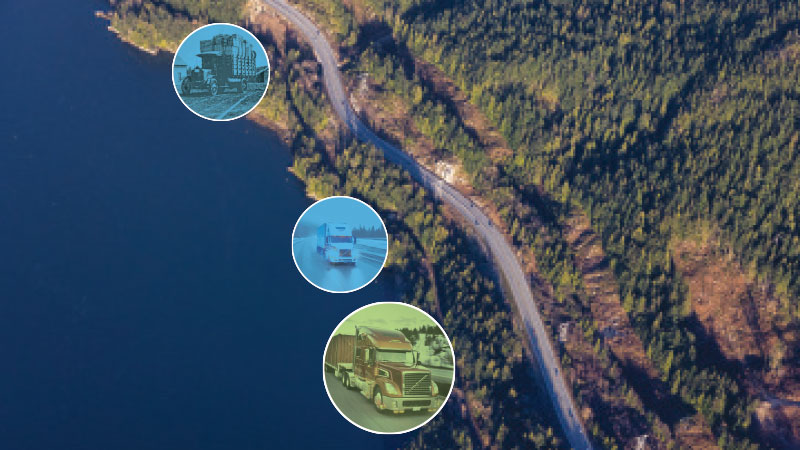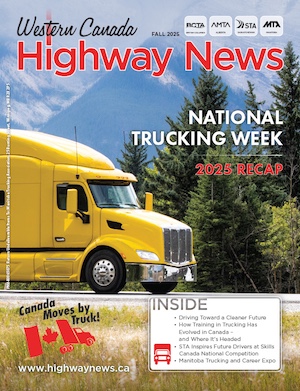Since 1913, BCTA has remained a member-based, province-wide, non-partisan, non-profit motor carrier association formed solely to advance the interests of British Columbia motor carriers.
BCTA includes among its members for-hire and private carriers hauling every conceivable type of freight, including manufactured goods, heavy specialized commodities, bulk products, household goods and general freight. We also represent motor coach, courier, and waste management companies and suppliers to the industry.
Some of our members are Canada’s largest trucking, courier, and motor coach companies, but the majority are small- to medium-sized, often family-owned enterprises.
Our motor carrier members operate about 16,000 vehicles, employ over 26,000 people, and generate approximately $2.2 billion annually in revenues in British Columbia.
For the last 110 years, through consultation and communication with our industry, government, and the public, we have promoted a prosperous, safe, efficient, and responsible commercial road transportation industry that contributes to the economy of British Columbia. Our promise for years to come is to maintain the exceptional trucking industry we’ve helped to shape, and we will continue to provide value to our members through programs and services.
When you consider British Columbia’s main industries, most people forget about transportation and warehousing. Road transportation is important but undervalued, despite employing more than 114,000 people (2021) in the province. It is the dominant mode for moving freight and passengers across the country.
Few countries are as dependent on an efficient transportation system as Canada, with its vast geography. Canada’s first thoroughfares were the waterways used by the Indigenous peoples. They were useful to fur traders, explorers, settlers, and soldiers; many of today’s roads follow the routes created long ago.
The Path to Advocacy
British Columbia’s history is closely tied to transportation. In fact, BC entered Confederation in 1871 on the promise of a connection to the Dominion, an important link for the financially struggling Crown colony. Initially, the transportation link was to be a wagon road, but when it took the Confederation delegation 24 days to travel from Victoria to Ottawa (by rail from San Francisco), a railway was the obvious solution. The federal government’s agreement to build a railway to the Pacific Coast ultimately connected west to east, opened the prairies to settlement, and advanced roads in BC.
BC’s first road, between Esquimalt and Victoria, was built by Royal Navy sailors in 1854, four years before gold was discovered near Hope. The Cariboo Road from Yale to Barkerville opened in 1865, giving coaches and freight wagons access to the Interior and the gold fields. It was built by Royal Engineers and private contractors, many of them miners whose gold rush efforts did not pan out. After the gold rush, the Cariboo Road was largely destroyed and abandoned.
Boom and Bust
In the first decade of the 20th century, Vancouver rode a wave of economic growth spurred on by the Klondike Gold Rush and the opening of Canada’s west. When the internal combustion engine replaced the steam engine, it opened possibilities for the efficient movement of goods over land. But cartage was restricted to urban areas of the Lower Mainland and Southern Vancouver Island. Driving from the Lower Mainland to the Interior required detouring through the United States. Nevertheless, moving freight was a lucrative business in the booming economy.
Then came the bust in 1913. That same year, a group of freight handlers met in Vancouver to form the General Cartage and Storage Association (GCSA), the precursor of today’s BC Trucking Association (BCTA).
Their goal was to advocate for issues affecting them – roads, rates, and regulations. They strove for security in numbers during the declining economy. And then the First World War changed everything; gasoline, tires, and young men were all fed into its voracious maw.
The post-war period brought new opportunities everywhere, including in the freight business, where horses gave way to trucks. The automobile craze of the 1920s made cars and trucks more affordable and renewed interest in the old Cariboo Road. After nearly 50 years, it was rebuilt as the Fraser Canyon Highway.
Trucking Organizes
In 1926, the Canadian Trucking Alliance (CTA) was established. It is now a federation of the seven provincial trucking associations. Its mandate to monitor federal regulations includes lobbying the federal government to maintain a level playing field for the industry between Canada and the United States. Members of the trucking associations are automatically members of the CTA.
In 1930, the GCSA was reinvented as the Commercial Motor Vehicle Owners’ Association (CMVOA). It was just in time for the Great Depression, which ruined businesses, financial institutions, and individuals. Competition rose in BC’s trucking industry as businesses fell. Vancouver implemented weight restrictions, and operators realized more than ever the need to organize. In 1934, the CMVOA was replaced by the Motor Carriers’ Association (MCA), which lobbied for regulations to stop intense competition wherein big companies wanted to block small start-ups that could undercut them. The BC government established the Motor Carrier Branch (MCB) in 1940 to regulate licensing and tariffs.
While the government established regulations, the MCA was changing. Small operators felt the organization favoured big businesses, so some left to create their own organization, the Automotive Transport Association (ATA). By the end of the Second World War, ATA had 187 member companies and the MCA only 50. Realizing they needed one voice, the two organizations settled their differences and merged asthe Automotive Transport Association of British Columbia (ATABC) in 1946.
Wanted: More Trucks
When the world went to war again, it increased the demand for raw resources, manufactured goods, ships, aircraft, and vehicles, including trucks. The demands on the transportation industry were huge and were complicated by a labour shortage. The federal government declared the trucking industry essential to the war effort.
After the war, the world rebuilt, and road development boomed. Essentially every aspect of life in Canada changed as new highways and streets increased efficiency in transportation. The Trans-Canada Highway was proposed by Parliament in 1949 and officially opened in 1962, although construction continued until 1971.
Licensing
As new roads took trucks into and between urban areas, BC’s municipal licence plates became a problem. Municipalities had the authority to license commercial vehicles that operated within their borders, with the revenue important for maintaining the new roads. But freight carriers had to buy a licence plate for each municipality in which they worked. Harvie Malcolm, former volunteer president of BCTA cited by Daniel Francis in his excellent history of BC trucking, said, “When I first got into the trucking side of the business [the 1940s], we had to have something like at least a dozen different licences, just to get as far as Hope.
The ATABC lobbied for years to end local plates, which were finally recognized as ‘a barrier to inter-provincial road transport.’ In 1963, the province introduced a new system that required a single municipal licence plate for each for-hire truck. That system today is administered by the Union of BC Municipalities (UBCM); decals have replaced plates.
By the 1970s, the ATABC represented a large portion of BC’s trucking industry. The decade was marked by labour problems, rising fuel costs, irritation with government regulations, and competition from the railways. In 1978, to bolster its public image and show the importance of the transport industry, the organization rebranded itself as the BC Motor Transport Association (BCMTA).
BCTA is Formed
In 1987, the BCMTA became BCTA, with the mandate to represent the interests of its members to federal, provincial, and municipal governments and to promote an efficient and safe industry.
Reimagining a Safer Industry
In the 1990s, vehicle safety became a big public issue due to a series of serious truck accidents. Recommendations from accident inquests recommended a range of improvements, including fines and
a hotline for reporting unsafe drivers. Paul Landry, the first full-time BCTA president, was responding to the media on a weekly, sometimes daily, basis.
Although reporting didn’t reflect the statistics and under-qualified drivers were the minority, the damage was done. In response, BCTA advocated for higher driver standards, more consequences for unsafe drivers and owners, and improvements to the National Safety Code. BCTA had been lobbying WorkSafeBC for a trucking safety council; in 2008, SafetyDriven – Trucking Safety Council of BC was formed.
Into the 21st Century
The 9/11 attacks on New York City and Washington caused security concerns and delays at the Canada-US border. New programs and technologies actually improved the speed of processing freight. Paperwork was transmitted electronically before reaching the border, and programs that pre-screened shippers expedited cross-border transit. Delays were still a problem at BC crossings, a situation alleviated in 2011 by an agreement to harmonize procedures on both sides of the border.
BC’s strong economy early in the 21st century meant increased consumer spending. Between 2007 and 2016, for-hire trucking in BC grew by 30%, at an average of 3% annually. In 2015 alone, truck transportation accounted for 1.05% of BC’s GDP. Heading into 2018, trucking was expected to grow by 5%.
At the Truxpo 2018 trade show (initially a BCTA initiative in 1988), speakers predicted the growth of the industry. Some expansion would be the result of zero-emission mandates for new construction coming into play, according to Fiona Famulak, Vancouver Regional Construction Association President.
Invisible Enemy
In November and December 2019, reports began appearing around the world of a new and highly contagious respiratory virus identified as COVID-19. It was declared a global pandemic on January 30, 2020. It had a profound effect on trucking and its associated industries – in other words, everything. WorkBC reported in 2020 that the transportation and warehousing industry had lost 12,600 jobs in 2019-2020.
Pandemic responses were chaotic. Trucking was identified as an essential service and exempt from many restrictions, but drivers who transported non-essential goods or supplied non-essential businesses were suddenly unemployed. Those who did still have routes encountered difficulties – limited washrooms and places to eat and quarantine measures on returning home.
As transportation resumed, drivers found their daily practices changed new sanitation measures in their vehicles, new protocols for pick-up and delivery, new personal protective equipment, no staff in offices, digital paperwork, long waits, temperature checks, health questionnaires, masks, being banned from restrooms, and sanitizer everywhere. BCTA called for delayed vaccine mandates and exemptions from COVID-19 testing at the international border and ensured members were kept informed. The new measures were disruptive, but few truck drivers contracted the virus, as CTA announced in 2020.
The pandemic impressed on the public the importance of trucking, especially as online shopping doubled. In recognition, SafetyDriven and several municipal groups organized free meals-for-truckers and found ways to support the drivers who delivered everything to everywhere and everyone.
Life Goes On
As COVID-19 relaxed its grip, life began to return to normal. WorkBC reported that employment in transportation and warehousing rose by 8,300 jobs. CTV reported that the proportion of women working in all positions in Canada’s trucking industry was over 15%, up from an average of 14.1% in 2019-2021. Women were disproportionately affected by job losses through the pandemic, and the increase restored women drivers to pre-pandemic levels.
As always, safety was foremost. In 2021,BCTA was involved in implementing the province’s Mandatory Entry-Level Training (MELT) for Class 1 driver’s licence applications. BCTA had participated in its development and now administers the MELT Grant Program to provide funds to support training for unemployed or under-employed employees of motor carrier members.
Challenges to Be Met
As early as 2004, the Conference Board of Canada published a report on the infrastructure challenges in Canada’s transportation industry. They projected a shortage of 25,000 to 30,000 for-hire truck drivers by 2020. That prediction has come to pass, largely due to the industry’s struggle to engage young people in a changing employment landscape.
BCTA, WorkBC, and SafetyDriven have been educating owners in the industry about how to attract the next generation of drivers. In 2015, acknowledging driver shortages and gender inequality in the transportation sector (only 3% of Canada’s truck drivers are women), the Government of Canada committed $421,720 to develop mentorship programs for women in trucking. Two years later, Vancouver’s YWCA began offering its Changing Gears Program to train eligible women to become qualified for a Class 1 driving certificate with Air Brakes Certification.
Dave Earle, President and CEO of BCTA, in his closing remarks at Truxpo 2018, declared that environmental sustainability “is going to define and drive the next 20 to 30 years of how every industry operates.” Commercial zero-emission mandates will require new technologies and ways of doing business.
In 2021, BCTA advocated for BC to expand weight allowances for electric and hydrogen co-combustion heavy-duty vehicles. As a result, BC became the first Canadian jurisdiction to approve the additional allowance.
The association also convinced the Province to address hazardous emissions control by using the existing Commercial Vehicle Inspection Program rather than creating new programs.Furthering its commitment to the environment, BCTA has aligned with the Province to help the industry reduce its emissions. Under the CleanBC Heavy-Duty Vehicle Efficiency Program, the government and qualified companies will share the cost of purchasing and installing fuel-saving equipment for heavy-duty vehicles. The Program educates the industry about driving practices that reduce fuel usage and related GHG emissions.


 1-866-985-9791
1-866-985-9791



